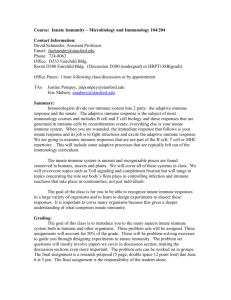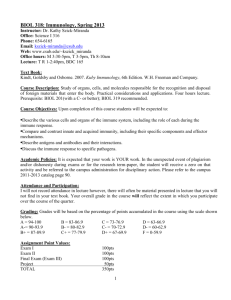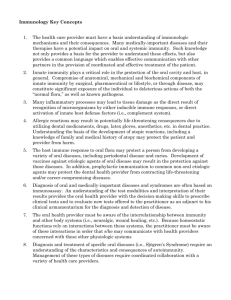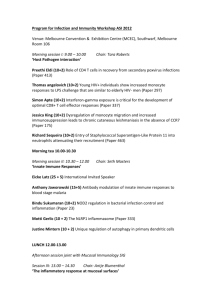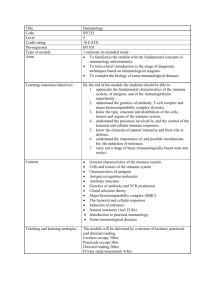Lecture 1 Notes
advertisement
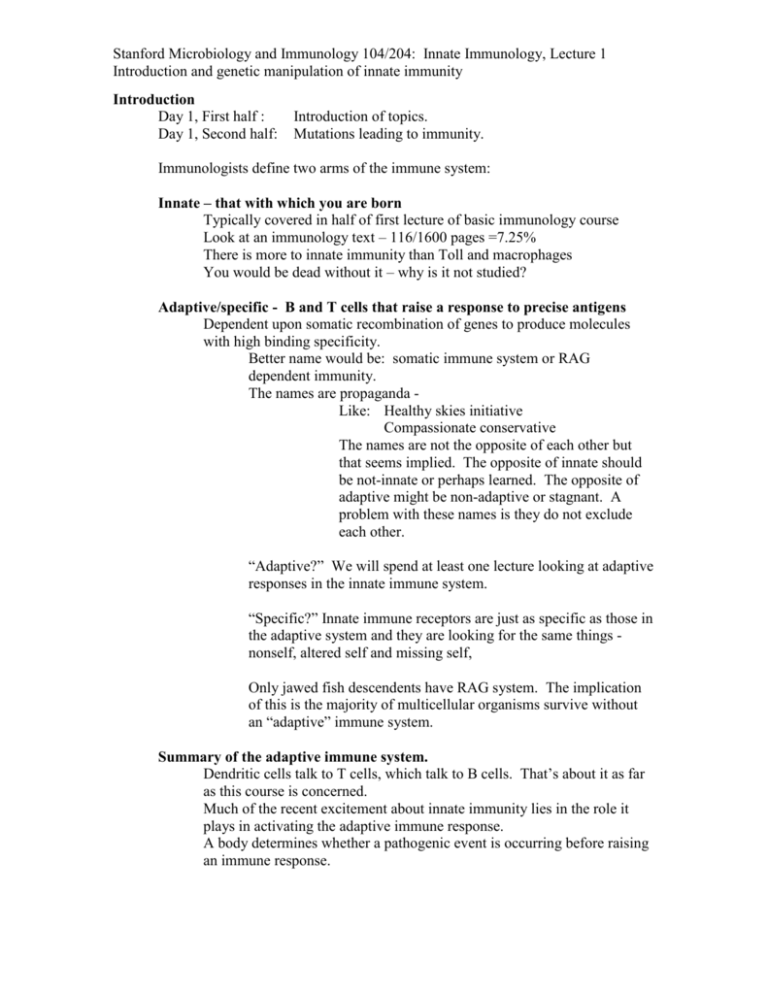
Stanford Microbiology and Immunology 104/204: Innate Immunology, Lecture 1 Introduction and genetic manipulation of innate immunity Introduction Day 1, First half : Day 1, Second half: Introduction of topics. Mutations leading to immunity. Immunologists define two arms of the immune system: Innate – that with which you are born Typically covered in half of first lecture of basic immunology course Look at an immunology text – 116/1600 pages =7.25% There is more to innate immunity than Toll and macrophages You would be dead without it – why is it not studied? Adaptive/specific - B and T cells that raise a response to precise antigens Dependent upon somatic recombination of genes to produce molecules with high binding specificity. Better name would be: somatic immune system or RAG dependent immunity. The names are propaganda Like: Healthy skies initiative Compassionate conservative The names are not the opposite of each other but that seems implied. The opposite of innate should be not-innate or perhaps learned. The opposite of adaptive might be non-adaptive or stagnant. A problem with these names is they do not exclude each other. “Adaptive?” We will spend at least one lecture looking at adaptive responses in the innate immune system. “Specific?” Innate immune receptors are just as specific as those in the adaptive system and they are looking for the same things nonself, altered self and missing self, Only jawed fish descendents have RAG system. The implication of this is the majority of multicellular organisms survive without an “adaptive” immune system. Summary of the adaptive immune system. Dendritic cells talk to T cells, which talk to B cells. That’s about it as far as this course is concerned. Much of the recent excitement about innate immunity lies in the role it plays in activating the adaptive immune response. A body determines whether a pathogenic event is occurring before raising an immune response. Stanford Microbiology and Immunology 104/204: Innate Immunology, Lecture 1 Introduction and genetic manipulation of innate immunity Ideally we would teach innate and adaptive immunity together in an integrated manner, along with pathogenesis. In this course, this is the end of our discussion of the Rag dependent immune system. Innate immune system In this class I will take a broad approach, looking at plants, nematodes, flies, mice and humans. There are several reasons for doing this: a. People and mice are not the only important creatures on the planet. Crops protect themselves only with innate immune responses. Insects pass on diseases, eat and pollinate our food. b. In a system with no RAG dependent immunity, immune responses must be innate. Studying these systems simplifies experiments. c. Immune responses are highly conserved; it should cease surprising us that the mechanisms used by other organisms are also used by humans. Will always try to teach course with an infection in mind. The reductionist approach to science has us discussing immunology in such a way that we seldom mention an infection. You begin to think the adaptive immune system evolved to reject transplants and cause autoimmune disease. Here we will always try to start with an infection, progress to the host’s response and then show how microbes can overcome the host. A bug’s eye view A useful way to organize the innate immune system is to imagine yourself as a microbe trying to enter a body. When looking for a host you quickly realize that not all hosts are created equal. Infection puts a selective pressure on a population that can lead tot the accumulation of mutations that allow survival to childbearing age. Sickle cell anemia is good example of this. Heterozygotes for the trait are less likely to die when infected by malaria. Where do you enter the body? Skin is a formidable immune organ. Wounds incite inflammation and summon immune cells. Wet surfaces contain antimicrobial compounds antimicrobial compounds like antimicrobial peptides and lysozyme. Fluid flow clears out microbes rapidly. - constant (peristalsis and beating cilia ) - induced (vomit, diarrhea, snot) Bodies are already inhabited by microbes that are unlikely to give up their niches easily. Stanford Microbiology and Immunology 104/204: Innate Immunology, Lecture 1 Introduction and genetic manipulation of innate immunity Passing through cells Manipulation of a host cell produces a strong immune response. – HR response in plants Once inside the body Toll activation – recognition of foreign Complement – opsonization and killing Phagocytes – uptake and killing mechanisms Physiological responses Inflammation Shock Cachexia Neural contributions Neuroendocrine effects – glucocorticoids Direct neural signaling Psychological contributions Feeling sick The “yuck” response of disgust Learned disgust responses Social innate immunity Infected social insects inform their sisters. Infected plants inform the field of imminent infection. Adaptive innate immunity Immune memory and innate immune responses. Loss of function mutations leading to disease resistance Infections can be species specific like smallpox, which only infects humans. Microbes can also be subspecific, like Plasmodium vivax, which can only infect people expressing the Duffy antigen on their red blood cells. This lecture concentrates on mutations arising in a community that alter resistance to infectious diseases. Because of your genetic background you might respond better or worse to an infection. Is this innate immunity? If we define innate immunity as an inborn method of combating disease, then mutations affecting disease progression fit. This is not a mechanism that is active at a personal scale – like most of the mechanisms we study. These mechanisms are active at the population level. Lessons learned from these mutations may lead to new treatments. Stanford Microbiology and Immunology 104/204: Innate Immunology, Lecture 1 Introduction and genetic manipulation of innate immunity Mutations implicated in altered immunity to infection Disease Gene Mechanism Malaria G6PDH Heterozygote survival advantage Sickle cell anemia Heterozygote survival advantage TNF promoter polymorphism Severe malaria Thalassemia Hemoglobin A ? ? CFTR – cystic fibrosis Receptor for Salmonella typhi CFTR – cystic fibrosis Limits diarrhea? CCR5 Enhanced NK activity Loss of HIV receptor TLR2 Polymorphism leads to shifts tuberculoid to lepromatous TLF Presence of human lytic factor prevents infection Factor V Leiden Mutation results in increased survival Typhoid fever Cholera AIDS Leprosy Ngana Sepsis Themes Loss of an essential component for infection. Bacillus thuringiensis resistance in insects as a model We are in a position to watch the evolution of traits in the wild as insects become resistant to Bt insecticides and transgenic crops. B. thuringiensis Insect and nematode pathogen Produces a spore and a toxin crystal. Closely related to B. anthracis – considered same species by some. Infection cycle grossly resembles anthrax: eat the spores – bacteria turn the cow into more spores. Insect – eat spores and crystal toxin. Gut ruptures and septicemia ensues. Bacteria turn the caterpillar into more spores. Infected insects have an interesting behavioral change in which they climb to the top of the leaf and hang on even after death, raining their contaminated remains upon their brethren. Toxin mechanism – cleaved by gut protease Stanford Microbiology and Immunology 104/204: Innate Immunology, Lecture 1 Introduction and genetic manipulation of innate immunity Binds receptor Changes conformation, inserts into membrane and forms a pore. Practical use – very insect specific Used as insecticide – in fact it is acceptable for organic farming. As an aside, it is interesting that germ warfare is an acceptable wmd for organic farming but not nerve gases (most chemical insecticides) are not. These toxins are now used in transgenic plants to fight insects. To date several types of resistance have been noted: Lack of toxin processing Increased toxin breakdown Reduction in receptor binding Increases in non-specific binding Recently, the story became more complicated because it turns out that B.t. isn’t the killer and neither is the toxin: the real killer is the native flora of the gut. Axenic caterpillars don’t die when fed B.t. toxin. Replenishment of the gut flora leads to death. In this case the gut flora work against the host. It is important to remember that we are an ecosystem and not simply sterile human beings. There are several examples of receptor loss leading to disease resistance in humans: Malaria – CCR2 expression polymorphism – Duffy coat antigen People with an expression polymorphism that reduces expression on RBCs are not infected by P. vivax. This suggests the parasite duffy binding protein could be a candidate for a blocking vaccine. HIV – CCR5 – a receptor for HIV CFTR – Receptor for some Salmonella typhi strains. Resetting the immune balance G6PDH Shows up clinically as sensitivity to fava beans and oxidants Somewhat protective as parasites are sensitive to oxidation Drugs – what if you slightly increase oxidative stress Italian grandmothers already know this secret. Together mutation and a dose of beans should reduces growth of parasites. Stanford Microbiology and Immunology 104/204: Innate Immunology, Lecture 1 Introduction and genetic manipulation of innate immunity Cultural process – eat beans but not too many – keeps you from dying from malaria. Mutating the source of pathology Cystic fibrosis and cholera CFTR is a chloride pump found on the apical surface of cells. Cholera toxin ADP ribosylates a G protein resulting in constitutive activation of the protein. This in turn activates adenylate cyclase leading to increase camp levels. CFTR is a cAMP responsive transporter and increases chloride transport, leading to massive diarrhea. In theory, a reduction in CFTR levels could reduce the severity of the disease. Mouse experiments – mixed results with cholera infections. The maximum chloride transport rates were identical in wild type and CFTR heterozygous mice but the integral of total chloride transported is lower in the heterozygotes. Recently this work has been revisited with drugs that block the CFTR and reduce diarrhea in cholera and E.coli models.

